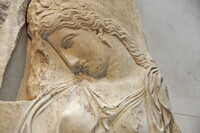| dc.coverage.spatial | Site: Metropolitan Museum of Art (New York, New York, United States) 35.11.3 | en_US |
| dc.coverage.temporal | ca. 27 BCE-14 CE (creation) | en_US |
| dc.creator | Kallimachos | en_US |
| dc.date | -27-14 | en_US |
| dc.date.accessioned | 2016-08-23T18:14:15Z | |
| dc.date.available | 2016-08-23T18:14:15Z | |
| dc.date.issued | -27-14 | en_US |
| dc.identifier | 268063 | en_US |
| dc.identifier.other | archrefid: 3449 | en_US |
| dc.identifier.uri | http://hdl.handle.net/1721.3/184388 | |
| dc.description | Detail, head and torso showing depth of relief; Copy of a Greek relief of ca. 425-400 BCE attributed to Kallimachos; the Roman adaptation dates from the Early Imperial (Augustan) period. Maenads were mythical women inspired by the god of wine, Dionysos, to roam the mountains and forests, singing and dancing in a state of ecstatic frenzy. This figure, wearing an ivy wreath and carrying a thyrsos (fennel stalk) bedecked with ivy leaves and berries, moves forward, trancelike, her drapery swirling about her. She was copied from a famous relief of dancing maenads dated to the late fifth century BCE, when Euripides portrayed the manic devotées of Dionysos in his play the Bacchae. Source: Metropolitan Museum of Art [website]; http://www.metmuseum.org (accessed 5/12/2015) | en_US |
| dc.format.medium | Pentelic marble | en_US |
| dc.rights | © Scott Gilchrist, Archivision, Inc. | en_US |
| dc.subject | human figure | en_US |
| dc.subject | mythology (Classical) | en_US |
| dc.subject | Dionysus (Greek deity) | en_US |
| dc.subject | dance | en_US |
| dc.subject | dancing | en_US |
| dc.subject | Imperial (Roman) | en_US |
| dc.subject | Classical | en_US |
| dc.title | Marble relief with a dancing maenad | en_US |
| dc.type | image | en_US |
| dc.rights.access | Licensed for educational and research use by the MIT community only | en_US |
| dc.identifier.vendorcode | 7A3-MMA-GC-DM-A02 | en_US |
| vra.culturalContext | Roman (ancient) | en_US |
| vra.technique | carving (processes) | en_US |
| vra.worktype | relief (sculpture) | en_US |
| dc.contributor.display | after Kallimachos (Greek (ancient) sculptor, active 2nd half of 5th century BCE) | en_US |

